Lusitanosaurus
Lusitanosaurus (meaning "Portuguese lizard") is a genus of large basal thyreophoran dinosaur from the Sinemurian stage of Early Jurassic of Portugal. It is the second example of the group from the Lower Jurassic of Europe and it is the oldest known dinosaur from the Iberian Peninsula. It is based on a large left maxilla with teeth[1] that was lost in the fire at Museu Nacional de História Natural e da Ciência, Lisbon, in 1978.[2]
| Lusitanosaurus Temporal range: Late Sinemurian | |
|---|---|
 | |
| Lusitanosaurus liasicus restoration | |
| Scientific classification | |
| Domain: | Eukaryota |
| Kingdom: | Animalia |
| Phylum: | Chordata |
| Clade: | Dinosauria |
| Clade: | †Ornithischia |
| Clade: | †Thyreophora |
| Genus: | †Lusitanosaurus |
| Species: | †L. liasicus |
| Binomial name | |
| †Lusitanosaurus liasicus Lapparent & Zbyszewski, 1957 | |
Description
The fossil consists of a single partial left maxilla, an upper jaw bone, with seven teeth. The jaw measured 10.5 cm, with an estimated skull of 38.7 cm for the living animal. The teeth possess similarities with that of Scelidosaurus, which approaches it narrowly by the presence of important anterior and posterior basilar points on each tooth. The maxilla was clearly bigger, being the double of the size than the maxilla of Scelidosaurus. Lapparent & Zbyszewski vinculated it originally with Scelidosaurus and assigned the two to Stegosauria, he described that the teeth present were different to Scelidosaurus. Ginsburg cited the specimen and note a bigger size than the holotype of Scelidosaurus.[3] Lusitanosaurus was probably a semibipedal to quadrupedal herbivore, with a dense armour on most parts of the body.
History of discovery
The genus was first described by Albert-Félix de Lapparent and Georges Zbyszewski in 1957.[4] The type species is Lusitanosaurus liasicus. The generic name is derived from Lusitania, the ancient Latin name for the region. The specific name refers to the Lias. The holotype was part of the collection of the Museu de História Natural da Universidade de Lisboa. The exact location of the find and the date of collection are unknown, which makes a correct geological dating difficult, but it can be inferred from the matrix rock that it has been discovered near São Pedro de Moel, in strata from the Late Sinemurian (Early Jurassic).[5] This would make it the oldest known dinosaur from Portugal.
Classification
It was originally assigned to the Stegosauria by de Lapparent, Lusitanosaurus is today considered a basal member of the Thyreophora, perhaps belonging to the Scelidosauridae, but this is tentative, as this family is considered paraphyletic. The fragmentary condition of the specimen does not help to identify it well, as it can be from different grades inside basal Thyreophora, such as a relative of Emausaurus. Some authors consider it a nomen dubium.[6][7]
Paleoenvironment
The São Pedro de Moel rocks consists on calcareous strata, mostly from Marginal Marine environments.[8][9] Outside Lusitanosaurus, fishes have been found on this rock, such as members of the genus Proleptolepis.[10] Ammonites are also common, such as Oxynoticeras, Bifericeras, Cheltonia and Plesechioceras.[11] Finally, this section is known for its calcareous nannofossils that expose the Sinemurian/Pliensbachian transition more detailed than in any part of Portugal.[12]
References
- Ulansky, R. E. (2014). Dinosaur classification. Basal Thyreophora & Stegosauria.
- Costa F, Mateus O (2019) Dacentrurine stegosaurs (Dinosauria): A new specimen of Miragaia longicollum from the Late Jurassic of Portugal resolves taxonomical validity and shows the occurrence of the clade in North America. PLoS ONE 14(11): e0224263. https://doi.org/10.1371/journal.pone.0224263
- Ginsburg (1964): Discovery of a scelidosaurian (ornithischian dinosaur) in the Upper Triassic of Basutoland. C. R. Acad. Sc. Paris, vol. 258 (24 February 1964). Group 9.
- A.F. de Lapparent & G. Zbyszewski, 1957, "Les dinosauriens du Portugal", Mémoires des Services Géologiques du Portugal, nouvelle série 2: 1-63
- Duarte, L. V., & Soares, A. F. (2002). Litostratigrafia das séries margo-calcárias do Jurássico inferior da Bacia Lusitânica (Portugal).
- Antunes, M.T. & Mateus, O. (2003). Dinosaurs of Portugal. C. R. Palevol, 2: 77–95.
- Mateus, O. (2019). Notes and review of the ornithischian dinosaurs of Portugal. Journal of Vertebrate Paleontology, 27.
- Duarte, L. (2004). The geological heritage of the Lower Jurassic of Central Portugal: selected sites, inventory and main scientific arguments. Rivista Italiana di Paleontologia e Stratigrafia (Research In Paleontology and Stratigraphy), 110(1).
- Duarte, L. V., Silva, R. L., Oliveira, L. C., Comas-Rengifo, M. J., & Silva, F. (2010). Organic-rich facies in the Sinemurian and Pliensbachian of the Lusitanian Basin, Portugal: Total Organic Carbon and relation to transgressive-regressive facies cycles.
- M. T. Antunes, R. B. Rocha, and S. Wenz. 1981. Faunule ichthyologique du Lias inférieur de S. Pedro de Muel, Portugal. Ciências da Terra (UNL) 6:101-116
- Comas-Rengifo, M. J., Duarte, L. V., Goy, A., Paredes, R., & Silva, R. L. (2013). El Sinemuriense Superior (cronozonas Oxynotum y Raricostatum) en la región de S. Pedro de Moel (Cuenca Lusitánica, Portugal). Comunicaçõe Geológicas.
- Plancq, J., Mattioli, E., Pittet, B., Baudin, F., Duarte, L. V., Boussaha, M., & Grossi, V. (2016). A calcareous nannofossil and organic geochemical study of marine palaeoenvironmental changes across the Sinemurian/Pliensbachian (early Jurassic,~ 191 Ma) in Portugal. Palaeogeography, Palaeoclimatology, Palaeoecology, 449, 1–12.
External links
- Antunes, M.T. & Mateus, O. (2003). Dinosaurs of Portugal. C. R. Palevol, 2: 77–95.
- Lusitanosaurus in the Paleobiology Database

